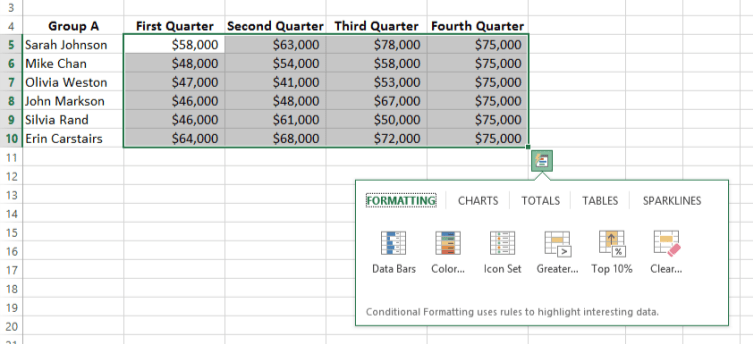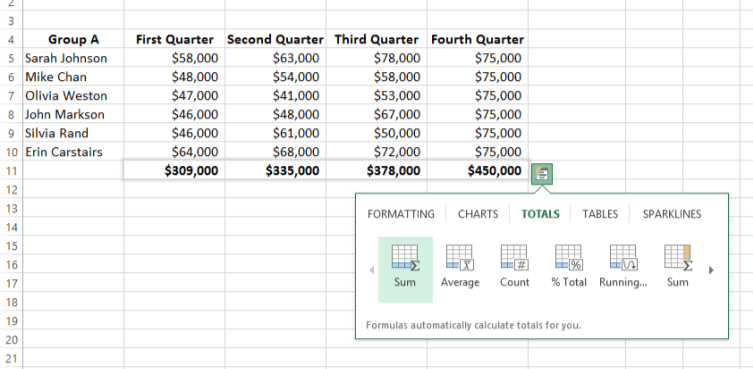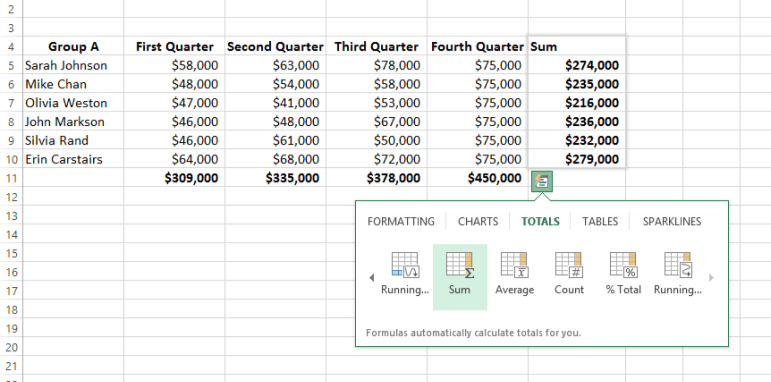Insert Automatic Totals with Microsoft Excel's Quick Analysis Tool
by Avantix Learning Team | Updated April 7, 2021
Applies to: Microsoft® Excel® 2013, 2016, 2019 and 365 (Windows)
You can sum or calculate other totals automatically in Excel using the Quick Analysis Tool. This awesome tool calculates totals for Sum, Average, Count, % Total and Running Total. All you need to do is decide if you want totals generated below or to the right of the selected range. You can even see a live preview of the totals before inserting them. In addition to calculating totals, you can also use the Quick Analysis tool to apply conditional formatting or to create charts and tables.
Recommended article: How to Delete Blank Rows in Excel (5 Easy Ways with Shortcuts)
Do you want to learn more about Excel? Check out our virtual classroom or live classroom Excel courses >
Selecting data to use with Quick Analysis
In order to use the Quick Analysis tool to insert totals, you'll need to select the cells containing the data you want to summarize and ensure that there is an empty column to the right or empty row below the selection so Excel can insert the totals. After you select the data, a Smart Tag will appear on the bottom right. Click on the Smart Tag to view the Quick Analysis Tools.
Using the Quick Analysis tool to insert totals below a selection
To use the Quick Analysis tool to calculate totals below a selection:
- Select the range of cells you want to summarize. A Quick Analysis Smart Tag icon appears in the lower right corner of the selection.
- Click the Quick Analysis Smart Tag icon or press Ctrl + Q. A gallery appears with tabs across the top with buttons below each tab.
- Click the Totals tab.
- Point to the button with the type of total calculation you would like to use such as Sum (if you simply point to the button, you will see a live preview). Click the left or right arrow to display more buttons if necessary.
- Click the button with the type of total calculation you would like to use. Select a button with blue highlighted cells at the bottom to insert the total below the range.
Using the Quick Analysis tool to insert totals to the right of a selection
To use the Quick Analysis tool to calculate totals to the right of a selection:
- Select the range of cells you want to summarize. A Quick Analysis Smart Tag icon appears in the lower right corner of the selection.
- Click the Quick Analysis Smart Tag icon or press Ctrl + Q. A gallery appears with tabs across the top and buttons below each tab.
- Click the Totals tab.
- Point to the button with the type of total calculation you would like to use such as Sum (if you simply point to the button, you will see a live preview). Click the left or right arrow to display more buttons if necessary.
- Click the button with the type of total calculation you would like to use. Select a button with yellow highlighted cells on the right to insert the total to the right of the range.
Turning Quick Analysis off and on
Quick Analysis is enabled by default. However, you can turn it off and on:
-
- Click the File tab in the Ribbon.
- Select Options. A dialog box appears.
- Choose General in the left pane (the default).
- In the User Interface Options area, check or uncheck the Show Quick Analysis Options On Selection.
- Click OK.
Check out the other options in Quick Analysis like conditional formatting and charts.
Subscribe to get more articles like this one
Did you find this article helpful? If you would like to receive new articles, join our email list.
More resources
10 Great Excel Navigation Shortcuts
How to Remove Duplicates in Excel (3 Easy Ways)
How to Merge Cells in Excel (4 Ways with Shortcuts)
How to Combine Cells in Excel Using Concatenate (3 Ways)
How to Replace Blank Cells in Excel with a Value from the Cell Above
Related courses
Microsoft Excel: Intermediate / Advanced
Microsoft Excel: Data Analysis with Functions, Dashboards and What-If Analysis Tools
Microsoft Excel: Introduction to Visual Basic for Applications (VBA)
Our instructor-led courses are delivered in virtual classroom format or at our downtown Toronto location at 18 King Street East, Suite 1400, Toronto, Ontario, Canada (some in-person classroom courses may also be delivered at an alternate downtown Toronto location). Contact us at info@avantixlearning.ca if you'd like to arrange custom instructor-led virtual classroom or onsite training on a date that's convenient for you.
Copyright 2024 Avantix® Learning
You may also like
How to Replace Zeros (0) with Blanks in Excel
There are several strategies to replace zero values (0) with blanks in Excel. If you want to replace zero values in cells with blanks, you can use the Replace command or write a formula to return blanks. However, if you simply want to display blanks instead of zeros, you have two formatting options – create a custom number format or a conditional format.
What is Power Query in Excel?
Power Query in Excel is a powerful data transformation tool that allows you to import data from many different sources and then extract, clean, and transform the data. You will then be able to load the data into Excel or Power BI and perform further data analysis. With Power Query (also known as Get & Transform), you can set up a query once and then refresh it when new data is added. Power Query can import and clean millions of rows of data.
How to Freeze Rows in Excel (One or Multiple Rows)
You can freeze one or more rows in an Excel worksheet using the Freeze Panes command. If you freeze rows containing headings, the headings will appear when you scroll down. You can freeze columns as well so when you scroll to the right columns will be frozen.
Microsoft, the Microsoft logo, Microsoft Office and related Microsoft applications and logos are registered trademarks of Microsoft Corporation in Canada, US and other countries. All other trademarks are the property of the registered owners.
Avantix Learning |18 King Street East, Suite 1400, Toronto, Ontario, Canada M5C 1C4 | Contact us at info@avantixlearning.ca










